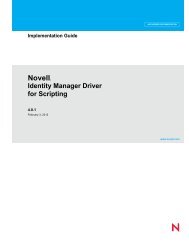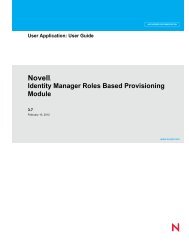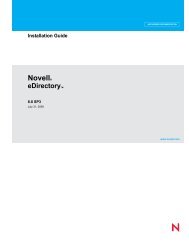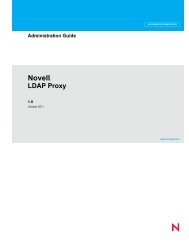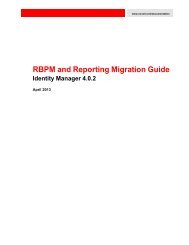Identity Manager 4.0.1 ID Provider Driver Implementation ... - NetIQ
Identity Manager 4.0.1 ID Provider Driver Implementation ... - NetIQ
Identity Manager 4.0.1 ID Provider Driver Implementation ... - NetIQ
Create successful ePaper yourself
Turn your PDF publications into a flip-book with our unique Google optimized e-Paper software.
This example configures the driver to request <strong>ID</strong>s from the wfid policy and store them in the<br />
workforce<strong>ID</strong> attribute whenever a new object is created or when someone tries to change this<br />
attribute. <strong>ID</strong>s from the uid policy are used for the unique<strong>ID</strong> attribute. The driver only issues <strong>ID</strong>s from<br />
an attribute if that attribute and the object class holding the attribute are in the Subscriber channel<br />
and the Publisher channel of the filter and are set to synchronize.<br />
NOTE: Attribute names must be in the <strong>Identity</strong> <strong>Manager</strong> namespace (not LDAP) and must be caseexact.<br />
Server Options<br />
Start RMI?: Controls whether the <strong>ID</strong> <strong>Provider</strong> starts an RMI service or not. An RMI service is needed<br />
if you request <strong>ID</strong>s from other clients than the driver for example, from DirXML Script policies or style<br />
sheets. If all <strong>ID</strong>s are managed through this driver’s filter and <strong>ID</strong> Generation Map settings, no RMI<br />
service is needed.<br />
RMI server: The IP address of the RMI server. Leave this field blank for the server to bind to all<br />
available addresses.<br />
RMI port: The TCP port of the RMI service. The default port for RMI is 1099. If that port is in use,<br />
change to a different port that is lower than 1024. If the port is in conflict, you see errors in the trace<br />
when the driver starts. The configuration assumes a port of 1099 to avoid common port conflicts.<br />
RMI Service port: The TCP port for the RMI <strong>ID</strong> <strong>Provider</strong> service. The server uses an ephemeral port<br />
if the value of this parameter is zero.<br />
RMI <strong>ID</strong> <strong>Provider</strong> Service IP: The IP address the client should use to connect to the RMI <strong>ID</strong> <strong>Provider</strong><br />
server. In a non-NAT environment, this is the IP address of the <strong>Identity</strong> Vault. In a NAT environment,<br />
this can be the address of the intermediate NAT device that routes the connection request to the<br />
<strong>Identity</strong> Vault.<br />
Use legacy <strong>ID</strong> Server schema: Enables the backward-compatibility mode when migrating an<br />
existing <strong>ID</strong> server configuration to run with the new <strong>ID</strong> <strong>Provider</strong> shim. True allows you to use legacy<br />
<strong>ID</strong> policies which do not use the schema that ships with the <strong>ID</strong> <strong>Provider</strong> driver.<br />
Trace level: Select On to enable the <strong>ID</strong> <strong>Provider</strong> trace level, not the driver trace level.<br />
A.1.6<br />
ECMAScript<br />
Enables you to add ECMAScript resource files. The resources extend the driver’s functionality when<br />
<strong>Identity</strong> <strong>Manager</strong> starts the driver.<br />
A.1.7<br />
Global Configurations<br />
Displays an ordered list of Global Configuration objects. The objects contain extension GCV<br />
definitions for the driver that <strong>Identity</strong> <strong>Manager</strong> loads when the driver is started. You can add or<br />
remove the Global Configuration objects, and you can change the order in which the objects are<br />
executed.<br />
32 <strong>Identity</strong> <strong>Manager</strong> <strong>4.0.1</strong> <strong>ID</strong> <strong>Provider</strong> <strong>Driver</strong> <strong>Implementation</strong> Guide




